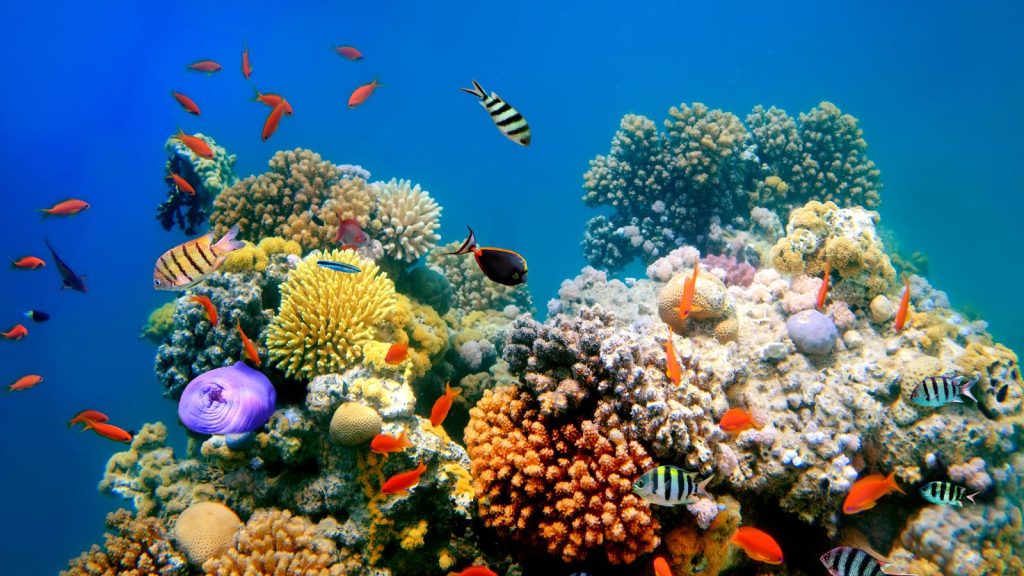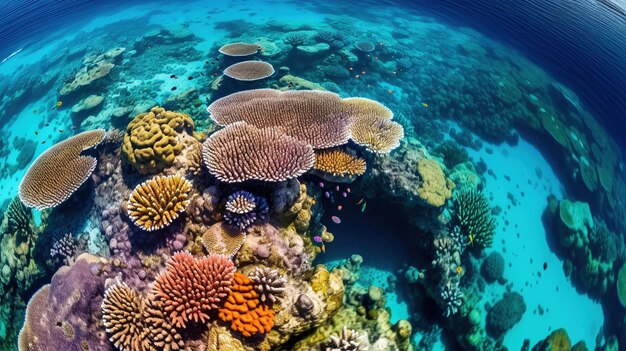The Majestic Great Barrier Reef: Welcome to the breathtaking world of the Great Barrier Reef, Australia’s natural treasure. Stretching over 2,300 kilometers along the northeastern coast, this majestic wonder is a haven of unparalleled beauty and biodiversity. Recognized as a UNESCO World Heritage site, the Great Barrier Reef boasts a vibrant ecosystem that supports an abundance of marine life and provides endless opportunities for exploration and adventure.
When it comes to natural wonders, few can rival the splendor of the Great Barrier Reef. Its sheer size and grandeur make it visible even from outer space, while its intricate coral formations mesmerize divers and snorkelers alike. The kaleidoscope of colors, shapes, and textures found beneath the crystal-clear waters will leave you in awe and inspire a deep appreciation for the wonders of the natural world.
As home to an astonishing array of marine life, the Great Barrier Reef is a treasure trove waiting to be discovered. Dive deeper into its depths and encounter awe-inspiring creatures such as harmless reef sharks, graceful manta rays, and the elusive dugong. From tiny clownfish peeking out of their anemone homes to elegant seahorses swaying with the current, each encounter is a testament to the incredible diversity and fragility of this remarkable ecosystem.
Visiting the Great Barrier Reef is a truly transformative journey. Its status as a UNESCO World Heritage site reflects its global importance and the need for its preservation. Take the time to understand the best seasons for a visit, ensuring you witness the reef in all its splendor. Whether you’re a nature lover, an adventure seeker, or simply seeking an unforgettable vacation, the Great Barrier Reef is Australia’s natural treasure that will leave a lasting impression on all who behold its majesty.
Exploring the Diving Spots in The Majestic Great Barrier Reef
When it comes to diving adventures, few places compare to the Great Barrier Reef. With its vast expanse of crystal-clear waters and breathtaking underwater landscapes, this iconic Australian destination offers divers a world of exploration and discovery. Whether you’re a seasoned diver or a beginner, there are plenty of diving spots within the Great Barrier Reef that cater to every level of expertise.
The diving spots in the Great Barrier Reef are renowned for their vibrant coral reefs and diverse marine life. Here are just a few of the popular locations that divers should explore:
- Ribbon Reefs: Located in the northern part of the Great Barrier Reef, the Ribbon Reefs are a collection of nine individual reef systems. Divers here can expect to encounter an abundance of colorful coral formations and an array of marine species, including reef sharks, turtles, and giant clams.
- Osprey Reef: Situated in the Coral Sea, Osprey Reef is a remote and pristine diving destination. This submerged atoll offers divers the opportunity to explore dramatic drop-offs, underwater caves, and stunning coral gardens. Don’t be surprised if you come across schools of hammerhead sharks or the occasional manta ray.
- Cod Hole: As the name suggests, Cod Hole is known for its friendly giant potato cods who have become accustomed to interacting with divers. This popular dive site, located near the northern end of the Great Barrier Reef, is also home to spectacular coral formations and an abundance of tropical fish.
Snorkeling Adventures in The Majestic Great Barrier Reef
Immerse yourself in the breathtaking beauty of the Great Barrier Reef through a thrilling snorkeling adventure. With its crystal-clear waters and vibrant marine life, this UNESCO World Heritage site offers an unforgettable experience for both beginners and seasoned snorkelers.
“Snorkeling in the Great Barrier Reef is like diving into another world. The colors, the shapes, and the sheer abundance of marine life are simply awe-inspiring.” – Jane Smith, avid snorkeler
One of the greatest advantages of snorkeling is its accessibility. Unlike scuba diving, snorkeling requires minimal equipment and no certification, making it suitable for all ages and swimming abilities. There are numerous snorkeling sites across the Great Barrier Reef, each offering its own unique underwater wonders.
As you explore the coral gardens, you will be greeted by a kaleidoscope of colors. The Great Barrier Reef is home to over 1,500 species of fish, 600 types of coral, and countless other marine creatures. Keep your eyes peeled for clownfish hiding among the anemones, graceful sea turtles gliding through the water, and mesmerizing schools of tropical fish.
Top Snorkeling Sites in The Majestic Great Barrier Reef
| Snorkeling Site | Location | Highlights |
|---|---|---|
| Flynn Reef | Cairns | Thriving coral gardens, colorful marine life |
| Opal Reef | Port Douglas | Diverse coral formations, snorkeling with turtles |
| Agincourt Reef | Port Douglas | Crystal-clear waters, sand cays, vibrant corals |
| Mackay Reef | Cairns | Abundant fish species, marine conservation area |
Discovering the Rich Marine Life of the Great Barrier Reef
The Great Barrier Reef is teeming with an astonishing array of marine life, making it a paradise for underwater enthusiasts and nature lovers. From vibrant coral gardens to majestic marine creatures, this World Heritage site offers unforgettable encounters with some of the most fascinating species on the planet.
Exploring the Underwater Kingdom
As you dive beneath the turquoise waters of the Great Barrier Reef, you’ll enter a vast underwater kingdom that captivates the senses. Schools of tropical fish in a kaleidoscope of colors dart through the coral maze, creating a mesmerizing spectacle. You might spot the recognizable clownfish nestled among the anemones, just like in the beloved movie, Finding Nemo.
“The Great Barrier Reef is like entering a whole new world—a world filled with wonder, beauty, and surprising discoveries beneath the surface.” – Marine biologist, Sarah Johnson
Welcoming you to its realm are majestic sea turtles gliding gracefully through the waters. These ancient creatures have called the Great Barrier Reef home for thousands of years, and witnessing them in their natural habitat is a truly awe-inspiring sight.
For those seeking a thrill, encounters with reef sharks provide an adrenaline-pumping experience. These sleek predators showcase the incredible diversity of marine life in the reef’s ecosystem while instilling a sense of respect and admiration.
Conservation Efforts to Protect the Great Barrier Reef
The Great Barrier Reef is not only a stunning natural wonder but also a fragile ecosystem that requires dedicated conservation efforts to ensure its long-term survival. The reef faces significant challenges from climate change and human activities, which have resulted in coral bleaching, habitat destruction, and the decline of marine species populations. Thankfully, scientists, organizations, and communities are working tirelessly to protect and restore this extraordinary marine ecosystem.
Challenges Posed by Climate Change
Climate change poses a significant threat to the Great Barrier Reef as rising sea temperatures can lead to coral bleaching, a process where corals expel the symbiotic algae that provide them with essential nutrients and vibrant colors. This bleaching event weakens the corals and makes them more susceptible to disease, ultimately resulting in their death. The frequency and severity of coral bleaching events have increased over the years, highlighting the urgent need for climate action to reduce greenhouse gas emissions and mitigate the impacts on the reef.
Human Activities and their Impact
While climate change poses a major threat, human activities also contribute to the challenges faced by the Great Barrier Reef. Pollution from agricultural runoff, coastal development, and improper waste disposal can harm the water quality and disrupt the delicate balance of the ecosystem. Overfishing and improper fishing practices can deplete fish stocks and harm other marine species. Additionally, tourism, if not managed sustainably, can result in physical damage to the reef and its fragile coral structures.

Must-See Tourist Attractions in the Great Barrier Reef
When visiting the Great Barrier Reef, there are several must-see tourist attractions that should be on every traveler’s itinerary. From breathtaking natural landmarks to thrilling activities, the region offers a wide range of experiences that showcase the beauty and wonder of this natural treasure.
Famous Landmarks
One of the most iconic attractions within the Great Barrier Reef is the Heart Reef. This stunning coral formation is shaped like a heart and is best appreciated from the air. Take a scenic helicopter tour to witness this unique natural wonder and capture unforgettable aerial views.
Another renowned landmark is Whitehaven Beach, consistently ranked as one of the world’s most beautiful beaches. With its crystal-clear waters, pristine white sand, and picturesque surroundings, Whitehaven Beach is a true paradise for beach lovers. Spend a day exploring the beach, swimming in the turquoise waters, and immersing yourself in the serene atmosphere.
Activities and Adventures
For those seeking adventure, the Great Barrier Reef offers a plethora of exhilarating activities. Embark on a snorkeling expedition to explore the colorful coral reefs up close and encounter a vibrant array of marine life. Dive into the clear waters and witness the wonders that lie beneath the surface.
In addition to snorkeling and diving, visitors can also indulge in island exploration. The Great Barrier Reef is home to numerous picturesque islands, each with its own unique charm. From the idyllic Green Island to the secluded Fitzroy Island. There are plenty of opportunities to relax, enjoy nature, and partake in various water sports.
Quotes
“Visiting the Great Barrier Reef is a truly magical experience. The combination of natural beauty and diverse marine life is awe-inspiring. Make sure you don’t miss out on the must-see attractions like Heart Reef and Whitehaven Beach to fully appreciate this incredible destination.”
– Jane Mitchell, Travel Enthusiast
The Majestic Great Barrier Reef: A UNESCO World Heritage Site
The Great Barrier Reef, located off the coast of Australia, is not just a natural wonder but also holds the prestigious title of being a UNESCO World Heritage site. This recognition is a testament to the reef’s outstanding universal value and its importance for all of humanity.
To be designated as a UNESCO World Heritage site, a place must meet certain criteria. The Great Barrier Reef fulfills several of these criteria, including its exceptional natural beauty, its role as an example of significant ongoing ecological and biological processes, and its significance as a unique habitat for an extraordinary range of marine life.
Being a UNESCO World Heritage site brings numerous benefits to the Great Barrier Reef. It helps raise international awareness about the importance of protecting and preserving this fragile ecosystem. It also encourages sustainable tourism practices, scientific research, and collaboration among nations to safeguard the reef for future generations.
“The Great Barrier Reef is not just a national treasure for Australia, but a global treasure. Its remarkable biodiversity and ecological importance make it a site of profound significance for the entire world.” – Dr. Emma Johnston, marine biologist

Timing Your Visit to the Great Barrier Reef
Planning a trip to the Great Barrier Reef? To make the most of your experience, it’s essential to consider the best time to visit this incredible natural wonder. The timing of your visit can significantly impact your encounters with marine life and the overall weather conditions.
The ideal time to visit the Great Barrier Reef is during the Australian summer, which falls between November and February. During this period, the water is warm, averaging around 26°C (79°F), creating the perfect conditions for snorkeling and diving. The visibility is usually excellent, allowing you to discover the vibrant marine world up close.
While the summer months offer prime diving and snorkeling conditions. It’s worth noting that this is also the peak tourist season. If you prefer a more peaceful and less crowded experience, consider visiting during the shoulder seasons of spring (September to November) and autumn (March to May). These periods still provide pleasant weather and visibility, but with fewer crowds.
Frequently Asked Questions
The Majestic Great Barrier Reef: What makes the Great Barrier Reef a natural treasure in Australia?
The Great Barrier Reef is considered a natural treasure in Australia due to its unique beauty and biodiversity. It is home to a vast array of marine life, including colorful coral reefs, fish, turtles, and sharks. This iconic UNESCO World Heritage site is one of the most remarkable natural wonders on Earth.
The Majestic Great Barrier Reef: Can I go diving in the Great Barrier Reef?
Absolutely! The Great Barrier Reef offers a multitude of diving spots for both experienced and novice divers. You can explore breathtaking underwater landscapes, swim alongside vibrant coral formations, and encounter an incredible variety of marine species. It’s truly a diver’s paradise.
The Majestic Great Barrier Reef: Are there snorkeling opportunities in the Great Barrier Reef?
Yes, snorkeling in the Great Barrier Reef is a popular and accessible activity. There are numerous snorkeling sites where you can witness the wonders of the underwater world. From shallow reefs teeming with colorful fish to mesmerizing coral gardens, snorkeling in the Great Barrier Reef is an adventure not to be missed.
Find out more at: https://tinyurl.com/2eevnpzv












